#Spanish Caravaggisti
Text
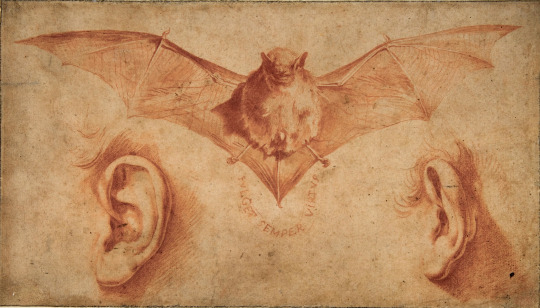
Study of Bat and Ears, Jusepe de Ribera, ca. 1622
#art#art history#Jusepe de Ribera#Lo Spagnoletto#drawing#chalk#figure study#animals in art#bats#Baroque#Baroque art#Spanish Baroque#Caravaggism#Spanish Caravaggisti#Spanish art#17th century art#Metropolitan Museum of Art
356 notes
·
View notes
Text

Francisco de Zurbarán (Spanish, 1598-1654) • Elizabeth of Aragon • c. 1635
Interesting read: This 650 year old saint's hand has never decomposed
#art#painting#art facts#fine art#art history#saints in art#portrait#de zurbarán#caravaggisti#baroque art#spanish baroque
4 notes
·
View notes
Text
Explaining one of VTMB paintings (pt 9)

Cain Killing Abel oil on canvas (Second quarter of 17th century) by Pietro Novelli
Pietro Novelli (March 2, 1603 – August 27, 1647) was an Italian painter of the Baroque period, active mainly in Palermo. He was born in Monreale, and died in Palermo. He initially trained with his father, a painter and mosaicist. His father died in 1625 from the bubonic plague.[2]As a young apprentice he was a fellow pupil with Gerardo Asturino.[3] In 1618, he moved to Palermo and apprenticed with Vito Carrera (1555–1623). His first dated work is from 1626: St. Anthony Abbot for the church of Sant'Antonio Abate in Palermo. The development of his style owed much to Anthony van Dyck, who visited Sicily in 1624 and whose altarpiece, the Madonna of the Rosary in the oratory of Santa Maria del Rosario in Palermo was highly influential for local artists. He was also commissioned works and paintings for many churches in Piana degli Albanesi, and various works to adorn the villas of the Sicilian nobility. Other influences on Novelli were the Caravaggisti or tenebrists active in Naples (for example, Ribera). Novelli also painted for the church of Santa Zita in Monreale, and painted a Marriage of Cana for the refectory of the Benedictines in Monreale.He was injured during the revolution in Palermo in 1647, and died from his wounds.[4] His pupils included Andrea Carreca, Francesco Maggiotto, Francesco Giselli, Michele Blasco, Vincenzo Marchese, Giacomo lo Verde, and Macri da Girgenti. He was also an architect and stage set designer. [1]
The term Baroque probably ultimately derived from the Italian word barocco, which philosophers used during the Middle Ages to describe an obstacle in schematic logic. Subsequently the word came to denote any contorted idea or involuted process of thought. Another possible source is the Portuguese word barroco (Spanish barrueco), used to describe an irregular or imperfectly shaped pearl, and this usage still survives in the jeweler’s term baroque pearl. Baroque art and architecture refers to the visual arts and building design and construction produced during the era in the history of Western art that roughly coincides with the 17th century. The earliest manifestations, which occurred in Italy, date from the latter decades of the 16th century, while in some regions, notably Germany and colonial South America, certain culminating achievements of Baroque did not occur until the 18th century. The work that distinguishes the Baroque period is stylistically complex, even contradictory. In general, however, the desire to evoke emotional states by appealing to the senses, often in dramatic ways, underlies its manifestations. Some of the qualities most frequently associated with the Baroque are grandeur, sensuous richness, drama, vitality, movement, tension, emotional exuberance, and a tendency to blur distinctions between the various arts. [2]
Below is an explanation of the Cain and Able story from real life and in the context of VTM. This is the same for all the Explained Cain slaying Able paintings in VTMB posts I’ve done so feel free to skip if you’ve already read this as it’s long.
___________________________________________________________
The tale of Cain murdering his brother Able are nearly identical in Jewish, Christian and Islamic texts with the oldest known version coming from the Dead Sea Scroll from the first century BCE. Cain was the the first born son of Adam and Eve and became a Farmer while Able was the second born son and became a shepherd. Both brothers made sacrifices to God, but God favored Abel's sacrifice instead of Cain's. In Islam the reason for their offerings is to decide which brother would marry Adam and Even’s first daughter who was also Cain’s twin sister. Able also had a twin sister and Adam wanted the brothers to marry the others twin. In multiple religions each brother has a twin sister but there is no consistently with the names as Cain’s twin sister being named Aclima, Kalmana, Lusia, Cainan, Luluwa, or Awan, and Able’s twin sister is named Jumella, Balbira or to make it more confusing Aclima (though even when she is called this Able’s twin sister is never the one the brothers are competing to marry) depending on the source. In the Islamic text Able’s offers his fattest sheep while Cain offered only a bunch of grass and some worthless seeds. In Jewish and Christian texts the reason for the sacrifices and the exact nature of their offerings are merely described as the first born of Ables heard and products from Cain’s fields.[3] The most description we get is in Genesis when God sees that Cain is upset that his offering was not chosen God tells Cain “: Why are you angry? Why are you dejected? If you act rightly, you will be accepted; but if not, sin lies in wait at the door: its urge is for you, yet you can rule over it.”(Genesis 4:6-7) Cain then told Able to meet him in his fields where he then murdered his brother out of jealousy by hitting Abel in the head with a stone. When God asks Cain where his brother Cain, “I do not know! he answered. Am I my brother’s keeper?”(Genesis 4:9) to which God replies “What have you done! The voice of your brother’s blood is calling to me from the ground. From now on you’ll get nothing but curses from this ground; you’ll be driven from this ground that has opened its arms to receive the blood of your murdered brother. You’ll farm this ground, but it will no longer give you its best. You’ll be a homeless wanderer on Earth.” (Genesis 4:10-12) When Cain objects saying the punishment is to great and that whoever finds him wandering shall kill him which then God says “No. Anyone who kills Cain will pay for it seven times over.” God put a mark on Cain to protect him so that no one who met him would kill him.” (Genesis 4:15). Cain then leaves east of Eden to wander in No-Mans-Land with his wife (who is not named in Genesis but is assumed to be his Twin sister in all tellings regardless of what name is given to her). Their first born Child was named Enoch, and Cain named the first city he built after his son. After Abel’s Death Adam and Eve had a Third son named Seth and when eve gave birth to him Eve said “God has given me another child in place of Abel whom Cain killed.”(Genisis 4:25-26). In some texts Seths wife and sister is named Azura. Their son is named Enosh it is through Seth’s line that humanity stems from, though both Cain and Seth had multiple decedents and confusingly used the same names (see family tree below). None of Cain’s decedents suffered the curse of their father Cain but where still seen as sinful and apart from God and where killed in the great flood. How Cain died is not as an agreed upon topic. He was ether crushed to death by the stone house he built, an irony as he used a stone to slay his brother or in some versions part of the Mark of Cain had him grow horns and his descendent Lamech (not to be confused with Lamech who decedent from Seth and was the father of Noah) who was a blacksmith and had two wives(this is viewed as sinful) killed him mistaking him for a wild animal and killed his own son Tubal-cain in the process.
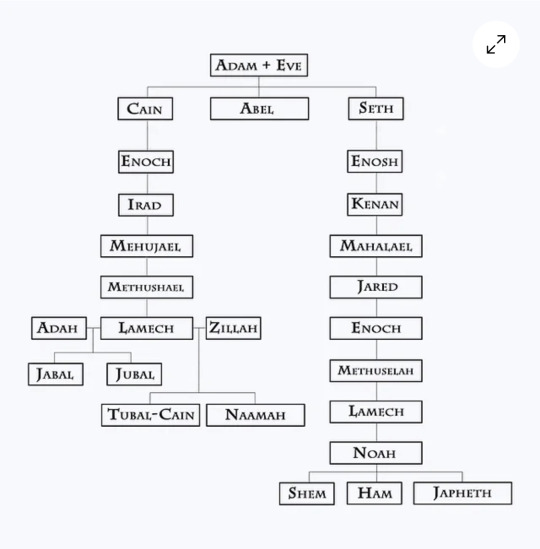
While in the lore of Vampire the Masquerade the tale of Cain killing his brother able as told in the Book of Nod stick to the original tale regarding the murder of Able but starts to differ in God’s punishment. "Father" cursed him with a mark, and cast him out to wander in darkness in the Land of Nod alone. There is no mention of a wife or if he was still cursed to be unable to farm however it is clear that Cain was not yet cursed to be a vampire by God. The Land of Nod was a place of utter darkness, with no source of light, where Caine was afraid and alone. There he found Lilith where they began a relationship and Cain realized that she possessed magical power and begged her to share them with him. While hesitant Lilith prepares an Awakening ceremony by cutting herself with a knife, bleeding into a bowl, and giving it to him so that he may drink. After Caine partakes of Lilith's blood, he is visited by three angels who are agents of God. Each angel offers Caine a chance to repent for the murder of Abel, but Caine rebuffed them out of pride. Michael, when denied, cursed Caine and his childer to fear his living flame. Raphael cursed Caine and his childer to fear the dawn, as the sun's rays would burn like fire. Uriel then cursed Caine and his childer to cling to Darkness, drink only blood, eat only ashes, and be frozen at the point of death, cursed so all they touch would crumble into nothing. A fourth angel, Gabriel, then appeared to offer the way of Golconda, the only way to "light", by the mercy of God. After the experience, Caine becomes officially "Awakened", possessing the following Disciplines: Celerity, Potence, Fortitude, Obfuscate, Dominate, Presence, Protean, Animalism, and Auspex. Caine then became aware of the Path of Blood, the Final Path from which all paths stem. And with all these powers, but now being cursed to be a vampire he breaks his bond with Lilith and leaves her.[3] While Cain never biologically fathers any children it is clear that their names of those he embraced and their decedents are inspired by the biblical names in his line though with massive changes. For instance the first city is founded by Cain in the land of Nod and and called Ubar and is explicitly stated to be settled by “Children of Seth” with the human king being Enoch at the time Cain settles there. Enoch still becomes his son as he is embraced by Cain. Another example of the reuse of a biblical name of Cain’s line is Zillah (which in Hebrew means shade or protection). In the original story she is one of Lamech(decedent of Cain) two wives( the other named Adah). After both wives discover that Lamech unwittingly kills Tubal-Cain(one of Lamech and Zillah’s sons) they both refuse to have sex with him because of the deaths he caused, on the pretext that they do not desire to give birth to cursed offspring. The three go together to the tribunal of Adam; Adam rules that they must obey their husband since he killed unwittingly. This midrashic tradition portrays Adah and Zillah as respected women, whose position is considered in all seriousness by the court. [4] In VTM Zillah was a human woman who lived in Udar so beautiful, Caine could not resist the Embrace. According to Nosferatu Zillah is the one of Cain’s second generation who sired their Antediluvian. Interestingly, even after the Embrace, Zillah did not desire him. It frustrated Caine to the point that he was ripping his hair out of his head. He did anything and everything to make her desire him. Yet, she would not have him. Finally, Caine sought the Crone's magic, who ultimately tricked him into a blood bond, she forced the First Vampire to Embrace her. The Crone sent her new thrall away, telling him that his blood would have the power to bond others as Caine himself was bonded to the Crone. The discovery of the blood bond was what finally made Zillah agree to marry her sire Caine. [3]
[1]“Pietro Novelli .” Wikipedia, Wikimedia Foundation, 14 Nov. 2022, https://en.wikipedia.org/wiki/Pietro_Novelli.
[2]“Baroque Art and Architecture .” Encyclopædia Britannica, Encyclopædia Britannica, Inc., https://www.britannica.com/art/Baroque-art-and-architecture.
[3] “Caine.” White Wolf Wiki, https://whitewolf.fandom.com/wiki/Caine.
[4] Kadari, Tamar. “Zillah: Midrash and Aggadah .” Jewish Women's Archive, https://jwa.org/encyclopedia/article/zillah-midrash-and-aggadah#:~:text=Zillah%20was%20a%20wife%20of,he%20unwittingly%20kills%20Tubal%2DCain.
#VTM#Vampire The Masquerade Bloodlines#VTMB#pietro novelli#cain and abel#baroque art#Explaining one of VTMB paintings#book of nod#Four painting for the price of one
3 notes
·
View notes
Note
What’s your favorite art styles? I personally love Dada/Surrealism/Baroque/Art Nouveau.
Caravaggisti in both Italy and the Netherlands
The Florentine High Renaissance period
The Spanish Baroque
5 notes
·
View notes
Photo
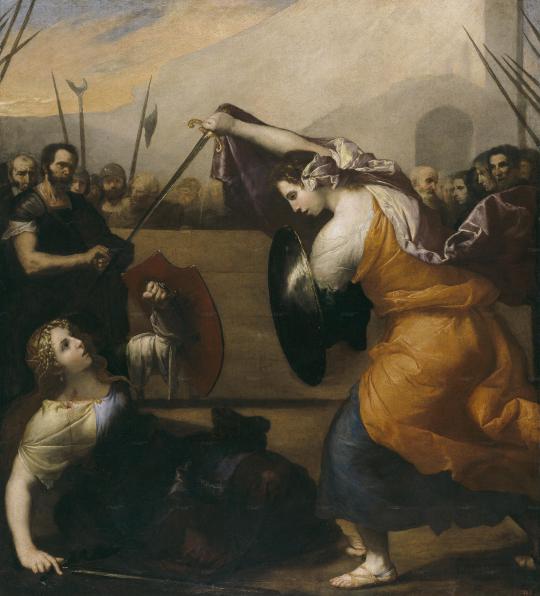
Jusepe de Ribera (Spanish, 1591-1652)
A Duel of Love, 1636
#Jusepe de Ribera#women in art#spanish art#valencian art#baroque#tenebrism#caravaggisti#1600s#1630s#*
798 notes
·
View notes
Text
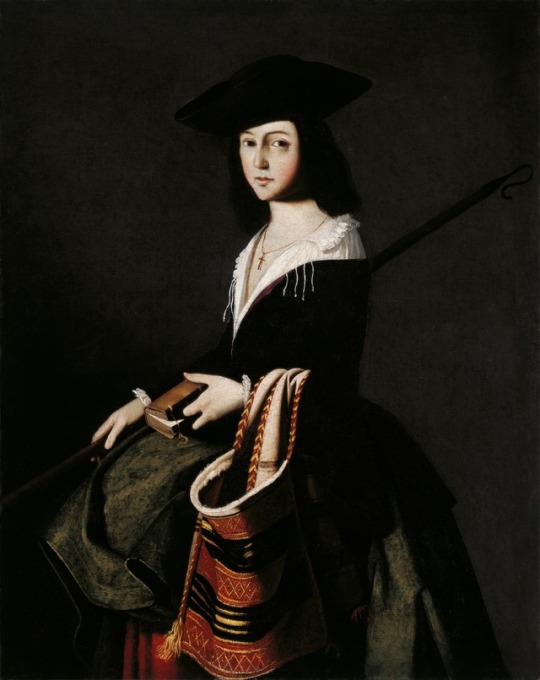
St. Marina (c. 1640-1650)
Francisco de Zurbarán (1598-1664)
6 notes
·
View notes
Photo

Francisco de Zurbarán (Spanish, 1598-1664)
Saint Francis in Meditation, 1635-9
Oil on canvas, 152 x 99 cm
Photo credit: The National Gallery, London
Art UK ®
The painting is one of the starkest and most austere of Zurbarans representations of saints. The face is largely obscured by the cowl and its shadows...
#Francisco de Zurbarán#Zurbaran#Francisco de Zurbaran#Baroque#Spanish Baroque#art#Caravaggisti#religious painting#mu art#mu
1 note
·
View note
Note
Speaking of artists, who are your all time favourite artists? And which art periods capture you the most? I love your blog and your taste is just out of this world exquisite!! Have a lovely week my darling! ♡
I can’t ever give a definitive list since there is yet so much to discover and so many works and artists that have enraptured me in so many different ways. In painting, my favorites are Jan van Eyck, Pietro Perugino, Hieronymus Bosch, Robert Campin, Pieter Brueghel the Elder, Sandro Botticelli, Leonardo da Vinci, Rogier van der Weyden, Michelangelo, Raphael, Caravaggio, Hans Holbein the Younger, Giotto, Piero della Francesca, Albrecht Dürer, Petrus Christus, Hugo van der Goes, Dionisius, Andrei Rublev, Filippo Lippi, Francisco de Zurbarán, Juan de Flandes, Clara Peeters, Kanō Eitoku, Diego Velázquez, Pontormo, Johannes Vermeer, Hokusai, Tawaraya Sotatsu, Hiroshige, Suzuki Kiitsu, Jusepe de Ribera, Artemisia Gentileschi, Diego Quispe Tito, Marcos Zapata, Francisco de Goya, Mikhail Nesterov, Vincent van Gogh, James Abbott McNeill Whistler, Gustav Klimt, Henri Matisse, Wassily Kandinsky, Paul Signac, Henri le Sidaner, Edvard Munch, Egon Schiele, Romaine Brooks, Horace Pippin, Gabriele Münter, Maurice Denis, Léon Spilliaert, Mikhail Vrubel, Marianne von Werefkin, Alexandre Benois, Gennady Spirin, Vilhelm Hammershøi.
Art periods/movements: Early Netherlandish (my absolute favorite), Early Italian Renaissance, Baroque/Caravaggisti, Dutch Golden Age, Spanish Golden Age, Edo, Azuchi–Momoyama, Vienna Secession/Jugendstil, Fauvism/Expressionism, Symbolism.
♡
76 notes
·
View notes
Text

The Resurrection " early 17th century detail
Artist: Cecco del Caravaggio
Oil on canvas
Cecco del Caravaggio (active c. 1610 – mid-1620 ), is the notname given to a painter who worked in Rome in the early decades of the 17th century and was an important early follower of Caravaggio (1571–1610). In the past art historians have suggested he may have been a Flemish, French or Spanish Caravaggist but more recently some have identified the artist with Francesco Boneri (or Buoneri), although this is not universally accepted.
An identification has also been made between Francesco Boneri/Cecco del Caravaggio and the boy who models for a number of paintings done by Caravaggio in the period 1600/1606, including the famous Amor Vincit and the John the Baptist in the Capitoline Museum in Rome.
The key influence on Cecco was Caravaggio, but other Caravaggisti such as Bartolomeo Manfredi formed an additional influence. His style exhibits common traits with the works of these other Caravaggisti such as the depiction of large, solid figures, strong contrasts between light and dark and complex drapery etc..
0 notes
Text
Im in love with the Baroque period, in case you cant tell
0 notes
Photo
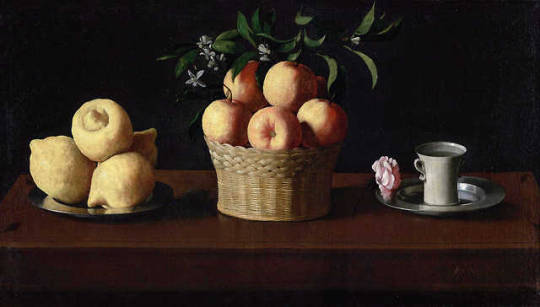
Francisco de Zurbarán (1598 -1664) was a Spanish painter. Primarily known for his religious paintings depicting monks, nuns, and martyrs but also for his still-lifes. Zurbarán gained the nickname Spanish Caravaggio, owing to the forceful, realistic use of chiaroscuro in which he excelled.
Still Life with Lemons, Oranges and a Rose is an oil-on-canvas painting by Baroque Spanish artist Francisco de Zurbarán completed in 1633. It is the only still life signed and dated by him and is considered a masterwork of the genre. The painting shows three groups of objects (a saucer of four citrons, a basket of oranges, and a saucer holding both a cup of water and a rose) resting on a table against a dark background. Each group of objects are placed at equal distant from one another and form a spatial and geometrical balance. Many of Zurbaran's works contained Christian themes, and the objects in the painting are often interpreted as having symbolic meaning as alluding to the Holy Trinity or as an homage to the Virgin Mary. The objects in this work are symbolic offerings to the Virgin Mary. Her love, purity and chastity are signified by the rose and the cup of water. The lemons are an Easter fruit that, along with the oranges with blossoms, indicate renewed life. The table is a symbolic altar.
To learn more about the Baroque era or the Caravaggisti enrol in the art appreciation course, online, flexible and fun! https://www.the-art-institute.com/landing
0 notes
Text
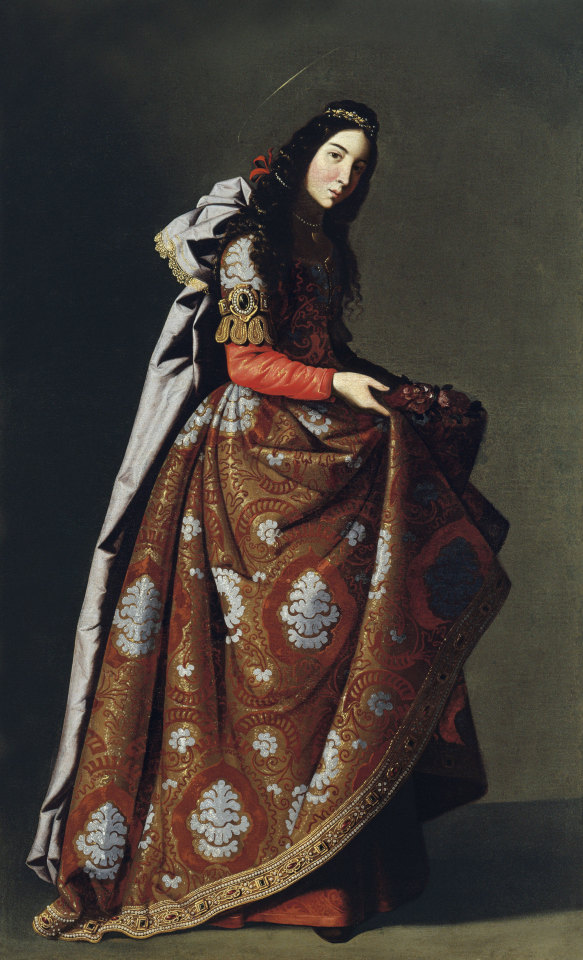
Santa Casilda, Francisco de Zurbarán, 1630-35
#art#art history#Zurbaran#Francisco de Zurbaran#religious art#Christian art#imaginary portrait#Casilda of Toledo#Baroque#Baroque art#Spanish Baroque#Caravaggism#Spanish Caravaggisti#Spanish art#17th century art#Thyssen-Bornemisza Museum#Museo Thyssen-Bornemisza
623 notes
·
View notes
Text

Cup of Water and a Rose on a Silver Plate, Francisco de Zurbarán, ca. 1630
#art#art history#Zurbaran#Francisco de Zurbaran#still life#Baroque#Baroque art#Spanish Baroque#Caravaggism#Caravaggisti#Spanish Caravaggisti#Spanish art#17th century art#National Gallery#National Gallery London
337 notes
·
View notes
Photo

Madonna and Child, Francisco de Zurbarán, 1658
#art#art history#Zurbaran#Francisco de Zurbaran#religious art#Christian art#Madonna and Child#Virgin and Child#Baroque#Baroque art#Spanish Baroque#Caravaggism#Caravaggisti#Spanish Caravaggisti#Spanish art#17th century art#Pushkin Museum
46 notes
·
View notes
Photo

The Annunciation, Francisco de Zurbarán, 1650
#art#art history#Zurbaran#Francisco de Zurbaran#religious art#Biblical art#Christian art#New Testament#Gospels#Annunciation#Baroque#Baroque art#Spanish Baroque#Caravaggism#Caravaggisti#Spanish Caravaggisti#Spanish art#17th century art#Philadelphia Museum of Art
93 notes
·
View notes
Photo

Ixion, Jusepe de Ribera, 1632
#art#art history#Jusepe de Ribera#Jose de Ribera#Lo Spagnoletto#classical mythology#mythological painting#Ixion#chiaroscuro#Baroque#Baroque art#Spanish Baroque#Italian Baroque#Neapolitan Baroque#Tenebrism#Caravaggism#Caravaggisti#Spanish Caravaggisti#Italian Caravaggisti#Spanish art#Spanish-Italian art#17th century art#Prado#Prado Museum#Museo del Prado
459 notes
·
View notes